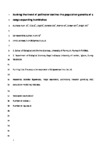Bucking the trend of pollinator decline: the population genetics of a range expanding bumblebee
| dc.contributor.author | Huml, JV | |
| dc.contributor.author | Ellis, Jonathan | |
| dc.contributor.author | Lloyd, K | |
| dc.contributor.author | Benefer, C | |
| dc.contributor.author | Kiernan, M | |
| dc.contributor.author | Brown, MJF | |
| dc.contributor.author | Knight, Mairi | |
| dc.date.accessioned | 2021-03-18T12:26:21Z | |
| dc.date.issued | 2021-03-19 | |
| dc.identifier.issn | 0269-7653 | |
| dc.identifier.issn | 1573-8477 | |
| dc.identifier.uri | http://hdl.handle.net/10026.1/16959 | |
| dc.description.abstract |
Recent research has shown drastic reductions in the global diversity and abundance of insects. This is a major concern given the expected cascade effects on ecosystem services, such as pollination. Understanding the patterns and drivers of changes in the distribution and abundance of species in our rapidly changing environment is therefore urgent. Cases of species showing trends that run counter to general population declines, especially when they deliver key ecosystem services, are especially interesting. The tree bumblebee (Bombus hypnorum), which belongs to a globally important group of pollinators, has substantially expanded its range in recent years in direct contrast to many other species within this group. Here we reconstructed the likely pattern of colonization of the UK based on RAD-seq population genomic data combined with Bayesian population modelling. This RAD-seq approach also enabled an analysis of genomic regions potentially under selection. We report a complex and dynamic colonization pattern that is most likely ongoing. Current evidence suggests that either a shift in its migration potential, and/or adaptive genomic changes have contributed to the recent range expansion of B. hypnorum. Genomic areas of potential adaptive significance included genes involved in regulation of transcription and gene expression, circadian rhythms and innate immunity. Our results are framed within the general context of understanding the factors driving successful population expansions. | |
| dc.format.extent | 413-442 | |
| dc.language | en | |
| dc.language.iso | en | |
| dc.publisher | Springer (part of Springer Nature) | |
| dc.subject | Bombus hypnorum | |
| dc.subject | Range expansion | |
| dc.subject | Pollinators | |
| dc.subject | Invasion genetics | |
| dc.subject | ABC population modelling | |
| dc.subject | RAD-seq | |
| dc.title | Bucking the trend of pollinator decline: the population genetics of a range expanding bumblebee | |
| dc.type | journal-article | |
| dc.type | Journal Article | |
| plymouth.author-url | https://www.webofscience.com/api/gateway?GWVersion=2&SrcApp=PARTNER_APP&SrcAuth=LinksAMR&KeyUT=WOS:000630625600001&DestLinkType=FullRecord&DestApp=ALL_WOS&UsrCustomerID=11bb513d99f797142bcfeffcc58ea008 | |
| plymouth.issue | 3 | |
| plymouth.volume | 35 | |
| plymouth.publication-status | Published | |
| plymouth.journal | Evolutionary Ecology | |
| dc.identifier.doi | 10.1007/s10682-021-10111-2 | |
| plymouth.organisational-group | /Plymouth | |
| plymouth.organisational-group | /Plymouth/Faculty of Science and Engineering | |
| plymouth.organisational-group | /Plymouth/Faculty of Science and Engineering/School of Biological and Marine Sciences | |
| plymouth.organisational-group | /Plymouth/REF 2021 Researchers by UoA | |
| plymouth.organisational-group | /Plymouth/REF 2021 Researchers by UoA/UoA06 Agriculture, Veterinary and Food Science | |
| plymouth.organisational-group | /Plymouth/REF 2021 Researchers by UoA/UoA07 Earth Systems and Environmental Sciences | |
| plymouth.organisational-group | /Plymouth/Users by role | |
| plymouth.organisational-group | /Plymouth/Users by role/Academics | |
| dcterms.dateAccepted | 2021-03-02 | |
| dc.rights.embargodate | 2022-3-19 | |
| dc.identifier.eissn | 1573-8477 | |
| dc.rights.embargoperiod | Not known | |
| rioxxterms.versionofrecord | 10.1007/s10682-021-10111-2 | |
| rioxxterms.licenseref.uri | http://www.rioxx.net/licenses/all-rights-reserved | |
| rioxxterms.licenseref.startdate | 2021-03-19 | |
| rioxxterms.type | Journal Article/Review |


